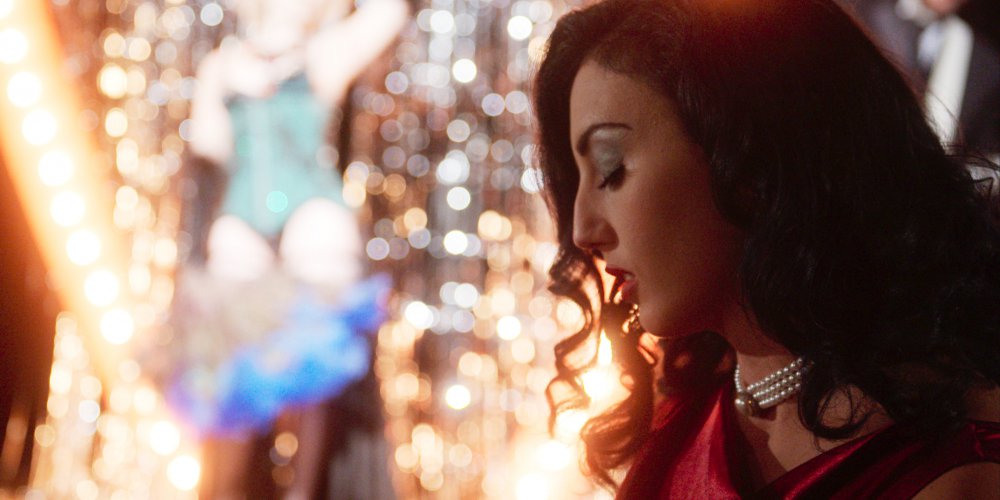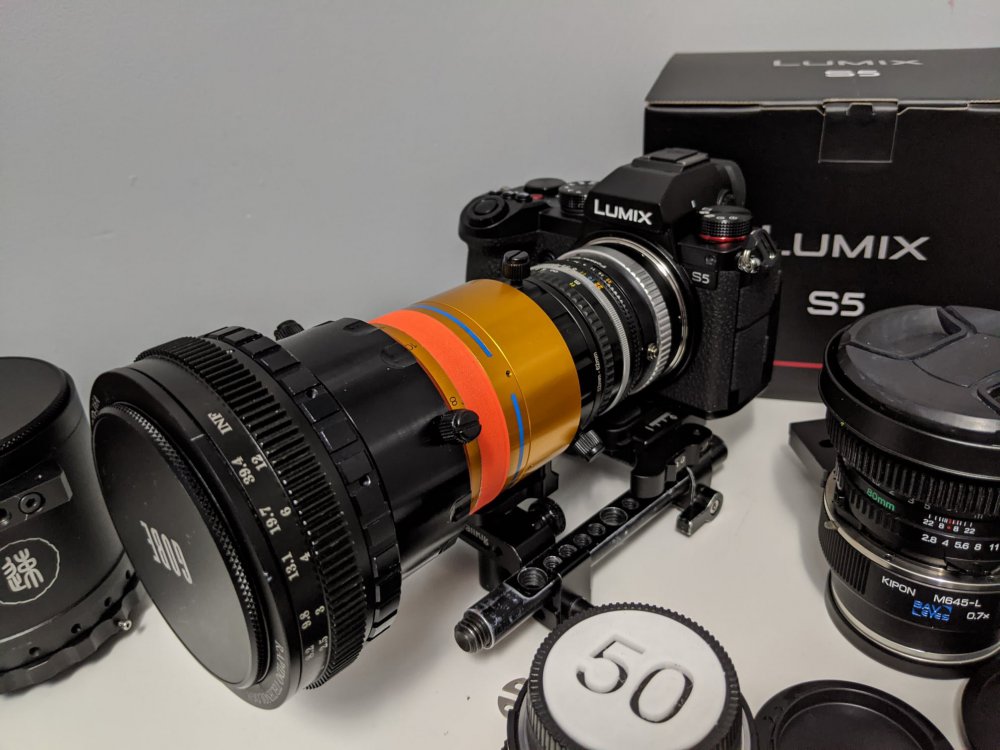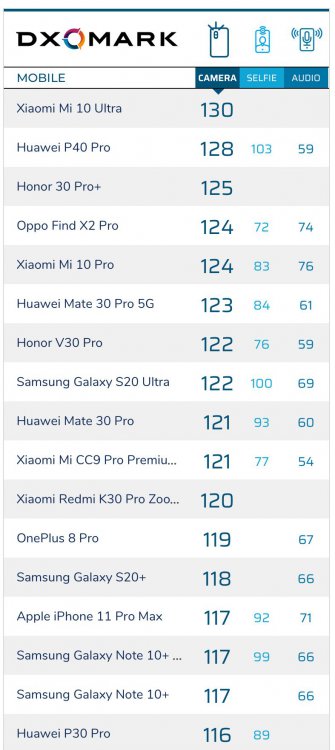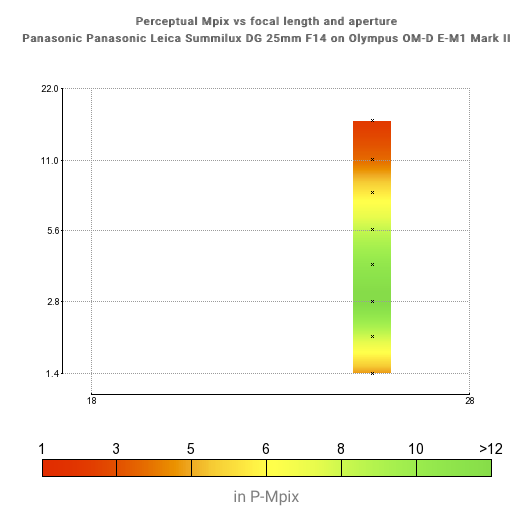Leaderboard
Popular Content
Showing content with the highest reputation on 09/20/2020 in all areas
-

Sony PMW-F3 with 2500 hours on it. Should I buy it?
TheRenaissanceMan and one other reacted to Geoff CB for a topic
2 points -
And that's exactly why I was asking for f2 or faster suggestions. So when I'm shooting in low-light conditions, I can still stop down a 1.4 lens to 2.8 and know I'll have a sharper image than using a 2.8 lens, wide open. And since this is for filmmaking, I'm mostly concerned about the center of the image anyway. The Voigtlander is very sharp wide open at f/1.4.2 points
-

Magic Lantern 3.3k 16:9 RAW now with real time preview
Katrikura and one other reacted to hyalinejim for a topic
Keep us posted! ML needs interpreters for us plebs as it's a bit esoteric 😂2 points -

Is full frame really necessary?
Rivhop and one other reacted to fuzzynormal for a topic
Sad day . To find out I’ve only been using parts of my images for years? Bummer.2 points -
get a EFS 18-135 STM without hesitation, I am shooting with this lens on My C100 MarkI every week, lightweight, perfect focus, silent, good color, versatile, you can not go wrong!!!1 point
-
R5 media thread: SD, CFexpress, SSD alternative
Juank reacted to Video Hummus for a topic
If this thing works I definitely want CFExpress on GH6 or any future camera. Or better yet, release a battery grip with a slot to take one of these larger M.2 SSD cards + extra battery.1 point -

DXOMark mobile camera rankings corrected
tomastancredi reacted to Andrew Reid for a topic
A nice side project... Mobile camera tests. It's good fun. I have so far tested: Xiaomi Mi 10 Pro Xiaomi Mi 10 Huawei P40 Pro Plus Huawei P40 Pro Huawei Mate 30 Pro Samsung Galaxy S20 Ultra iPhone 11 Pro Max Samsung Note 10+ Oppo Find X2 Pro (OnePlus 8 Pro is very similar) I'll keep it short. The big blog post is coming soon. But the DXOMark chart is wrong 🙂 Here's my EOSHDMark ranking: Huawei P40 Pro - 150 Pros: Superbly useful 5x zoom, overall camera quality, nice colours, price. Cons: IR pollution, screen size could be a bit bigger Huawei P40 Pro Plus - 150 Pros: Low light, overall camera quality, nice build. Cons: Lacks 5x module from P40 Pro, 10x module too long for regular use Huawei Mate 30 Pro - 140 Pros: Main camera again is superb like P40 Pro and 3x telephoto not bad either. Nice Samsung Note-like form factor & screen. Cons: Lacks 5x periscope camera of P40 Pro and overall zoom quality Xiaomi Mi 10 Pro - 135 Pros: 8K video and very good main camera, superb screen. Cons: Colours can be a bit clinical, a bit flat, 5x zoom quality is lacking compared to Huawei, back feels & looks cheap Xiaomi Mi 10 - 130 Pros: 8k video and very good main camera, superb screen. Cons: No 3x or 5x zoom modules and back feels / looks cheap. Oppo Find X2 Pro - 110 Pros: A good all-rounder, decent 5x zoom, market leading 3K 120hz screen. Cons: Poor tonality. Oversharpened camera output, beaten by Huawei. Poor choice of back material / weird finish iPhone 11 Pro Max - 105 Pros: Good dynamic range, natural colours, iOS, great build. Cons: Camera hardware dated compared to Chinese competition, poor zoom capabilities. Samsung Note 10+ - 100 Pros: Nice colours and decent main sensor, great form factor. Cons: Dated camera hardware especially compared to Huawei. Samsung Galaxy S20 Ultra - 95 Pros: Great in-hand feel and wonderful screen. Cons: Camera processing feels unfinished and is a complete let down, especially in low light. Mediocre 5x periscope zoom is soft. Main camera is muddy in low light and feels overly binned & over sharpened in good light. Xiaomi Mi 10 soundly beats it with same sensor! Expensive too! Google Play Store and Google Services installed OK on the Huawei phones. Couple of surprises: P40 Pro 5x optical zoom is the best on the market. Unfortunately they went crazy with the Plus version which is the flagship ($1000+) handset. That has a 10x optical zoom (240mm). It's way less useful than the 5x (135mm). Also the Plus version has a 3x optical zoom camera module, but I'll take the 5x over that any day. The other area of surprise is with colour - the Leica profiles on the standard P40 Pro are less "consumer". Much warmer and more day-glo on the Plus. One area where the Plus does win though is with build quality and low light. Also, there's fewer colour casts and less IR pollution indoors with black fabric, which come out almost purple on the P40 Pro. Also the P40 Pro has quite a cool and quite a green cast sometimes, especially in artificial light - and some will prefer the P40 Pro PLUS here. I find the P40 Pro quite artistic and moody looking though. One thing is for sure - 10x optical zoom lens on a smartphone is quite unique on the market - and when you have a use for it, it does deliver the goods for sure. Xiaomi Mi 10 Pro / Mi 10 / Samsung S20 Ultra share similar 108MP sensor. Xiaomi THRAAAASHES the Samsung. They just get much more out of it. Especially in low light, where the S20 Ultra is a mushy mess. Even the old Note 10+ has a preferable look in most circumstances to the S20 Ultra, and to make things worse the 5x optical zoom (actually more like 4x glass) is mediocre at best and significantly softer than the P40 Pro. Also the 8K video on the S20 Ultra is heavily cropped and looks dreadful, whereas the Mi 10 and Mi 10 Pro don't have a crop and again get much more out of the sensor in the processing. It is not 8K that pixel peeps well but it does make for very good 4K, even in low light. Downsides to the M10 Pro... the 5x zoom is pretty mediocre and noisy... and the Mi 10 makes do with nothing beyond 2x. Great screens though. Oppo Find X2 Pro puts in a good effort but it just looks brittle and thin compared to the Huawei on the main wide angle sensor. The ultra wide isn't as good either. The 5x is pretty good - nice and detailed, but dynamic range and colour lag behind the P40 Pro 5x. Indeed, the main sensor output fairs better for dynamic range but not for colour and it is a very over-sharpened output. I like the Oppo implementation of Android. Shame about the boring design of the back and the odd texture of the glass (has a kind of scratchy feel). Absolutely amazing 3K screen running at 120hz but not as bright in direct sunlight as the Xiaomi Mi 10 Pro and Mi 10 standard. There's a bit of a gap from the Huawei phones to everything else in my view. Especially with regards to tonality and the large 1" sensor look. Also the lenses are less flare prone when not absolutely grease free, compared to the Mi 10 Pro which is particularly badly effected and the Find X2 Pro. The iPhone 11 Pro Max fairs best for flare. The Apple device still has great dynamic range and the most natural looking colour - almost a flat look, good for filters. However it is distinctly backward from the Huawei and has that 'small sensor look' to it. The zoom is a complete non-starter against the 5x folded optics in the Huawei. I hope this helps anybody looking at the top 10 of DXOMark. The Xiaomi Mi 10 Ultra I have not yet tried but output looks a bit brittle and thin compared to the Huawei P40 Pro to me, judging by their own samples on the site. The zoom looks good. It shoots 8k. I shall have to try it. Oh and the Mate 30 Pro is my choice for a more "Note 10" handling style of Huawei phone - The main sensor is just as good as the P40 Pro in my opinion. Colours seem a bit closer to the Plus than the standard P40 Pro. Sometimes too consumer. But sometimes better with improved WB and less casts in low light. The 3x zoom is good in daylight. Less so in low light. It doesn't have the wow factor of the 5x on the P40 Pro though. I really wish Huawei had kept the 5x zoom on the P40 Pro Plus with the lovely build quality and ceramic back. I really wish they'd corrected the colour casts and IR pollution without throwing out the "Leica look". It can apply HDR too strongly sometimes even in the Leica profiles. The P40 Pro standard model does this too sometimes but not as often. Maybe they couldn't fit the 10x module and 5x into one phone!! DXOMark's numbers are too close together and don't reflect the differences in main sensor image quality well enough either: P40 Pro - 128 X2 Pro - 124 Mi 10 Pro - 124 Mate 30 Pro - 123 S20 Ultra - 122 The biggest problem is that S20 Ultra score - there is no way it is even in the same league as the others, especially in low light. Mate 30 Pro is significantly more than 1 point better than the S20 Ultra. Also there should be more than 4 points between the P40 Pro and the Oppo Find X2 Pro.1 point -
DXOMark mobile camera rankings corrected
Emanuel reacted to tomastancredi for a topic
I really liked the approach of this review, comparing cameras to ultraportable cameras ( even though phones will always have an usability advantage) https://spacedrone808.blogspot.com/?m=1 And this one shows the mi note 10 lite can be quite decent with app tweaking and newer sensor1 point -
lol, the only place I didn't look was in the thread title! 😂😂😂 There's a pretty well established principle that lenses sharpen up when you stop them down the first couple of stops. As mentioned before this has exceptions, but those exceptions seem to be just that, exceptions. DXOMark has a lot of interesting lenses and you can look at the graph of sharpness (perceptual megapixels) vs aperture to see how much it sharpens up when stopped down. Typically they look like this: Where wide open they aren't as good as when closed down a couple of stops. So in that sense, the target aperture really matters, as the best way to get a sharp image at f2 might be to buy an f1.2 lens. The exception is normally much slower lenses that have the same kind of optical performance as the above, only don't open the aperture as much.1 point
-
Absolutely. I have f0.95 primes, so you're preaching to the choir here! Actually, they didn't. Or at least, when I just re-read this thread five times looking for it, I couldn't find it! True. The issue I took, and thus my slightly sarcastic reply, was that this is viewed far too simplistically by people. Take two hypothetical lenses, one is f1.4 and the other is f2.8. Let's say that the f1.4 one isn't so sharp wide open, but the f2.8 lens is. The traditional, one-dimensional, thinking is that if you want sharp images then the 2.8 lens is the one to go for because "the f1.4 is soft wide-open but the f2.8 lens isn't", end of story, and mostly, end of how deep the persons knowledge is about the subject. The problem with this thinking is that the f1.4 lens might be sharper at f2.8 than the f2.8 lens is, but the sharp-wide-open one-dimensional thinkers don't go that far.1 point
-
Thanks guys. I picked up a used G9. It popped up for 769$ and Icouldn't pass it up. Should be here Tuesday!1 point
-

Sony A7S III
Juank reacted to Trek of Joy for a topic
A good look at the a7s3 with some ISO tests using various PP's. I'm personally still a fan of the Cine profiles since ETTR is my preferred way of working instead of playing the over exposure game. But looking forward to working with Slog3 too. Cheers Chris1 point -
Canon Cinema EOS C70 - Ah that explains it then!
currensheldon reacted to ntblowz for a topic
I m definitely keen on EVA-2 with L mount and similar size as those RF cinema cam. If they can push the 24MP more i be really keen too as I think it is the sweet spot.1 point -
I'd agree - if you want to stay with m43, the G9 is the way to go, it's a great hybrid stills/video camera with superb quality 1080p and no-sensor-crop 4k up to 60p, plus outstanding IBIS/EIS.1 point
-
This argument overlooks the use of speedboosters, the fact that smaller sensors can via adapters use lenses designed for larger sensors and the issue that many fullframe lenses have crops for certain frame rates.. ie Panasonic for 60p. For me the visual qualities I require come with codec and colour science. Not sensor size.1 point
-
This might be wishful thinking, but you're right. Not much needs to be done for Olympus to kick ass in MFT (sorry, watching too much Cobra Kai!). I will say, about their menus, the super control panel is the best thing since sliced bread. Decent slow-mo and internal, editable, 10-bit should be a top priority. Finally, they simply need to tweak their face detection to work at a greater distance from the subject. With all the rest being the same, it would be a winner! Again, ain't nobody goin to buy that GH6 with PDAF IMO. There are just too many other options at the same price-point. I'd rather run a two-camera setup with Blackmagic 4k and a Sigma quatro, or something there the likes.1 point
-
Not to mention Leica has said they “don’t have PDAF available to them” which makes me believe Sony has tight restrictions on PDAF patents. And the fact that other, old school camera companies such as Nikon, Fuji, Olympus have it has more to do with weird patent and technology agreements among those companies and perhaps Minolta in the past (or whoever acquired the original patent portfolio for it). Panasonic is a new comer in the camera industry, by a long shot, compared to those companies. And leica is a Germany camera competitor and we all know the Japanese vs German imaging battle that went on for years. Japan won the majority of the market. So I’m more included to believe that Panasonic is in the same boat as Leica and that they “don’t have PDAF available to them” so they built upon contrast based system. I’m not sure there are other ways to do focus except with lasers, or IR, or ultrasonic projection and apparently Panasonic doesn’t like those methods. It’s a mystery and would make a great “industry investigative story” documentary.1 point
-

Is full frame really necessary?
tupp reacted to hyalinejim for a topic
On the contrary, the last few pages of discussion gets right to the heart of the question raised. And I think many people would agree that the answer is: The necessity or desirability of a format size depend on whether the lenses available for that format will give you the visual qualities that you value.1 point -
None of it is even proving that fullframe is necessary. I could argue why shooting film is necessary and produces a look different to digital, but it still doesn't prove it necessary.1 point
-
how much time wasted in useless chatter...1 point
-
Hmm, tastiest of all threads! Besides the Eos M Super8 one or the lens thread or the BW on 8bit, of course.:) In the same league as the best of Eoshd classics. Anyway, such a fun thread. I love the these kind of youtube links, to some cool characters who provide great knowledge in an enjoyable way. Zeeks channel is really cool and fun! Thanks guys, for such great reading and viewing pleasures, nerdom and education!1 point
-
If you do NOT get things to match exactly there will ALWAYS be a small difference that will just leave SOME to say that because there is a difference the theory does not match the practice and THAT is what makes even trying a "fools errand" All the tests to date look close enough for me, if they do not for you, that is your problem and you should be doing the tests to match YOUR theory. You think the tests get close enough but then when you see a(often very small) difference you attribute that to a difference between formats instead of between the optics. There is no reason you would get a difference in vignetting if you used identical formula lenses to match the crop (IE scaled). As to your 600mm 8x10 above, That is a very different argument and actually plays into the original question and is again the reason WHY FF is necessary to ME. I simply can NOT match my ancient 300 2.8 with M43 (other than the $35000 plus Arri 150 1.3) or my ancient 24 1.4 (because there are no 12mm m43 f0.7 lenses) or my ancient 85 1.2 (again, no 42.5mm f0.65 lenses which is approaching the limit in air). No high quality tilt shift lenses either like my favourite 17 f4. If I could do what i can with m43 (or Pentax Q) what i can with FF, I would only be using that. A 8x10 camera with a 600mm lens will probably be something like a 600 f9 Nikon. A 600mm 8x10 f9 lens would be equivalent to about a 90mm 1.4 FF (so about a 45mm f0.7 M43). If you COULD get a lens to match it (it IS possible even if there are none) it would yield a very similar photo even without being the exact same lens design. If the lens was 600mm f8, then that would be almost impossible to match with m43 as that would be about a 90mm f 1.2 FF so you would need an aprox 45 f0.65 to even give a similar if not exact photo. You have yet to show that there is ANY difference BECAUSE of the differences in sensor size and so far all difference have been because of the optics and not getting an exact match. After all if the Moon astronauts had been just 2% off course, where would they be now?1 point
-

Is full frame really necessary?
Rivhop reacted to hyalinejim for a topic
Well, I think that DOF as defined by circle of confusion etc can be matched because equivalence theory states that you can, if the lens for the smaller format is bright enough. However, I would expect to see a considerably softer image with lots of vignetting as you'd need a very fast lens to replicate the narrow DOF of this shot, and that's how lenses behave wide open. So although the DOF might be technically the same, the images will look different. But this is caused by the glass, not sensor size. And yes, the selection of lenses available for different formats is different. So your choice of format will have an impact on the look of the image. But I think a lot of people are making the point that those differences are derived from the glass and are not inherent to the sensor size. So theoretically, sensor size makes no difference to DOF. But in practice DOF is rendered qualitatively differently because the lenses are different / behave differently / must be set differently for different formats. If true, it's an interesting dichotomy. But it does suggest that any equivalence test is really just a comparison of two different lenses. In the same way that one of my 50mm lenses looks different from the other 50mm lenses I have for the same format. So would you agree that once you match focal length and aperture for the same shot on different formats, you're comparing lenses?1 point -
Panasonic G9 (or even Olympus, if you don't mind missing out on 10bit, or wishing to wait/gamble on the future raw video from Olympus??) or Nikon Z5 (yes, I said "Z5", not Z6) are both definitely worth checking out. Fujifilm are worth taking a look at too, such as X-T3 or X-T4 Panasonic/Olympus would give you the better bang for your buck.1 point
-
Fuji X-T3 and X-T4 discussion
Xavier Plagaro Mussard reacted to Jay60p for a topic
Yeah, I put off installing new firmware for a month or two, sometimes it breaks more than it fixes. Good to hear a happy ending!1 point -
Why, BRAW is more about 12 bit colour than DR. You can see that in the colour holding up in my opinion better on the Pocket 6K footage, aside from some red clipping. A fullframe sensor is obviously going to be less noisy than a S35 one and this test focused very much on noise in shadow areas. Again comparing H264 to RAW, can be comparing no NR to some NR.. The advantages of RAW are more with changing ISO and WB and working with 12 bit colour. Given the S1 and S1H has better DR than the Pockets, its not hard to expect the S5 to follow in that line.1 point
-

Panasonic S5 Entry Level Full Frame seems to be real...
christrad reacted to Trankilstef for a topic
Interesting DR comparison between the S5 and the BMPCC 6K :1 point -
It's people realizing again image quality is more than specs.1 point
-
Thank you for doing that comparison! ... but, as you state, there were differences, nonetheless, even though zoom lenses were utilized for the test. The differences that I see are significant. In addition, the comparison suffers the same maladies that afflict all equivalency tests so far. The front and and rear limits to the DOF are not clearly shown. Also, not visible is the focus fall-off outside of the DOF range. Furthermore, the DOF is rather deep. The visual benefits of larger formats are more readily revealed by a shallower DOF. I don't think that they would match too much more closely than what is shown -- not with two primes and not with a shallower DOF and not with clearly showing the foreground and background limits of the DOF. Also, there seem to be some problems with the test that make it inconclusive. The images certainly wouldn't match if two dramatically different sized formats were compared, such as Super 16 and 8"x10". Perhaps one would do so to prove one's point. So, far I haven't seen a single equivalency test that actually demonstrates that two prime lenses made for different formats can match. Again, thank you for doing the test, but, unfortunately, the differences between the images are prominent, and the test suffers from many the same problems inherent in every DOF/equivalency comparison so far. The images from two different M4/3 primes of the same focal length would probably not look as different as the images shown in the test. To do a proper test, a lot more of the variables have to be controlled, and crucial data cannot be obscured (as seems to be the case in most such DOF tests). It's not easy to wrangle all of those elements, but nothing will be conclusive until somebody does it correctly. In the meantime, here is footage shot on Zev Hoover's 8"x10", reflective DOF adaper, and here's a video by our own @Gonzalo Ezcurra testing the focus and DOF on his 14"x14" MiniCyclops DOF adapter. Neither clips are making a DOF comparison with another format, but note how some of Gonzalo's shots intentionally show the foreground that is outside of the DOF range. I would like to see someone use M4/3 to match the looks in the above videos. Not sure how someone arguing with Brian Caldwell is relevant to the points made in this thread, but us "non-entities" should hold our ground!-1 points
-
You must have a very large penis.-1 points












